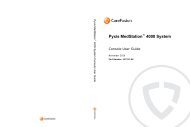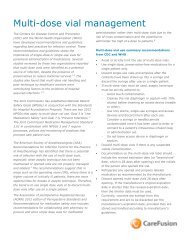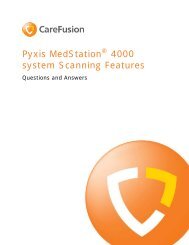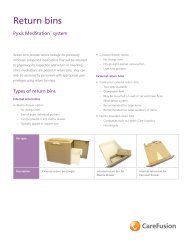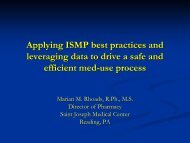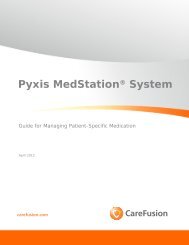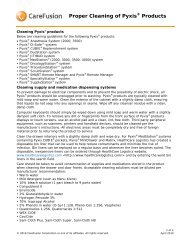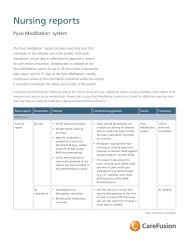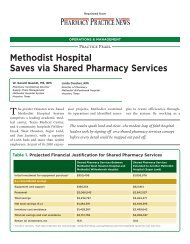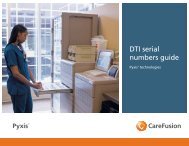Non-Controlled Medication Discrepancy Management - The Pyxis ...
Non-Controlled Medication Discrepancy Management - The Pyxis ...
Non-Controlled Medication Discrepancy Management - The Pyxis ...
Create successful ePaper yourself
Turn your PDF publications into a flip-book with our unique Google optimized e-Paper software.
Table 1: Types of Physical Counts<br />
Physical Counts Advantages Disadvantages<br />
Blind Count<br />
Requires the end user to<br />
enter the quantity instead of<br />
showing the expected<br />
beginning count and asking<br />
for confirmation or correction<br />
Verify Count<br />
Provides the end user with<br />
the expected beginning count<br />
and asks for confirmation or<br />
correction<br />
Accurate medication counts upon<br />
access of pocket<br />
If count IS performed, accurate<br />
medication counts upon access of<br />
pocket<br />
Increased time required during<br />
medication removal process<br />
Difficult to drive compliance<br />
IF COMPLIANT, requires same<br />
amount of time as BLIND COUNT<br />
<strong>Discrepancy</strong> Resolution<br />
When a discrepancy is created, depending on the software configuration, resolution will either be manual or<br />
automatic.<br />
<br />
<br />
Resolution-required discrepancies: <strong>The</strong> user is notified immediately and is required to resolve the<br />
discrepancy at the <strong>Pyxis</strong> MedStation. A discrepancy is documented as resolved when the reason or<br />
explanation statement is entered at the device.<br />
Auto-resolved discrepancies: <strong>The</strong> user is not notified of the discrepancy. A discrepancy is documented as<br />
resolved and no resolution is required.<br />
Common Reasons for Discrepancies<br />
<strong>The</strong>re are many causes of non-controlled medication discrepancies:<br />
A user removed a quantity greater or less than the quantity requested<br />
A user cancelled the removal, but removed the medication<br />
A user did not remove the medication requested<br />
A user made a typographical error (for example, 11 instead of 1)<br />
A user accessed the wrong pocket during remove, return, refill or load<br />
A user indicated incorrect quantity during refill or load<br />
A user diverted or pilfered a medication.<br />
Basic Elements for <strong>Non</strong>-<strong>Controlled</strong> Substance <strong>Management</strong><br />
An essential element to initially consider is the development of policies and procedures. Policies should be<br />
developed to address the prevention, identification, and monitoring of non-controlled discrepancies. A second<br />
essential element required is that of education. Multidisciplinary involvement is recommended to design an<br />
educational curriculum for ongoing staff education for pharmacy, nursing, respiratory and other providers (i.e.<br />
anesthesia department.) Lastly, a third area for consideration is that of accountability. Processes that drive<br />
accountability and compliance should be evaluated. Table 2 summarizes basic elements.




